Information and Exercise Leaflet for
Patients and Carers
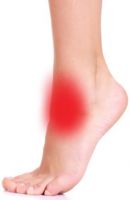
What is Ankle Impingement?
Ankle impingement is when the soft tissues close to the ankle joint can become ‘pinched’, inflamed and sore.
What causes Ankle Impingement?
All joints and soft tissues have a certain amount of activity that they can tolerate. This level can go up and down depending on how much activity you do. For example, following a period of rest or illness your activity tolerance can drop quite quickly. If you then perform an activity that takes you above this level, a painful reaction can occur.
Activities that can cause a painful reaction can include kneeling with your toes under you, deep squatting, uphill walking and a general increase in your normal daily activities. Often you may not get a painful reaction at the time of the activity. It can occur over the next 24 hours.
Should I be resting or moving?
For the first 24 to 48 hours after a painful reaction
- Try to rest your ankle but avoid long periods of not moving at all.
- Try to move your ankle gently for 10 to 20 seconds every hour when you are awake.
- If your ankle is swollen or warm, apply an ice pack wrapped in a damp towel to your ankle for 10-15 minutes every 2 hours.
After 48 hours
- You should try to use your ankle more.
- Do whatever you normally would and stay at or return to work. This is important and is the best way to get better.
- Avoid activities that cause a painful reaction until you have less discomfort and good movement.
- Gentle exercise really helps your ankle and can relieve pain.
Activity Diary and Modifications
It is sometimes useful to make a note of the daily activities that aggravate your pain. Below are some of the main ankle aggravators and some modifications you can make to help reduce the painful reaction.
| Ankle Aggravator | Modification |
|---|---|
| Kneeling with toes under you | If kneeling, try to kneel sitting on your heels with your toes pointing backwards |
| Walking up hills | Try to avoid excessively flat shoes, or use a heel wedge |
How do I know if my activities are causing a painful reaction?
It is common to get a painful reaction if too much load is put through the ankle. If this pain is more than 5/10 (with 10 being the worst pain imaginable) and lasts for more than 24 hours, check what you have been doing and ease back, but don’t avoid the activity altogether.
Once the pain has settled you can start to gradually progress your activities and exercises again. If you have a mild aggravation (pain is less than 5/10) and this settles within 24 hours, you can keep going with your exercises and gradually return to full activities.
Should I take painkillers?
Painkillers can help you keep moving however, it is important to discuss this with your GP, especially if you are taking any other medication(s)
Should I use ice or a heat pad?
If you have had an injury or a flare-up of an old problem in the last two days, you can apply an ice pack wrapped in a damp towel to your ankle for 10-15 minutes every 2 hours. Alternatively, you could try sports sprays and gel packs, which do a similar job.
After two days, you may find that heat is more helpful. You could use a heat pad or a hot water bottle with an insulated cover on it. Make sure this is not too hot and not directly touching your skin. You should do this for 10 to 15 minutes, three to four times a day. You can also continue to use ice to help reduce the pain and further swelling.
What about work?
There is no evidence to suggest that staying off work and reducing normal activities will improve the ankle impingement. Often returning to work will help you recover faster. If your ankle still hurts, your manager may be able to support you to do altered duties until you are ready to progress back to normal duties. Try to stay active and remember to keep moving.
What about sports?
You should take time before you take part in any sports after an ankle problem. If you take part in sports too soon you could aggravate your pain. You should have no swelling and be able to move your ankle fully before recommencing sports. You should have full, or close to full, strength and be able to take your weight through your leg without limping. Remember to stretch and warm up fully before sports.
Warning Signs
If you develop new or worsening symptoms, if you are unwell with the pain, or under the age of 16 years, seek medical advice.
The following symptoms are very rare, but if you suddenly develop any of them, you should seek urgent medical attention at your local Urgent Care Centre.
- Sudden onset of Achilles pain, with a “pop” or snapping sound/sensation.
- Inability to weight-bear through the foot/ankle.
- New significant injury to the leg/foot/ankle.
- Constant night pain in the foot/ankle (that prevents rest/sleep).
- Significant swelling, colour change or temperature change in the foot/ankle or extending up the leg.
- Lumps in the foot/ankle.
- Signs of infection i.e. night sweats that are out of the ordinary, high temperature and feeling unwell.
- Unexplained weight loss
If your symptoms fail to improve within 6-8 weeks with this regime you should contact your doctor for a physiotherapy referral.
If your symptoms are improving (even slowly), continue for up to 3 months.
Exercises for Ankle Impingement
Do not work into pain but it is OK for your muscles to feel tired. If the number of repetitions or length of the hold is too long, back off slightly, but aim to build up to the stated level.
Use the reaction rules to guide your exercise intensity. If pain is stopping you engaging in rehab, you should speak to your GP about pain relief promptly.
Flare-ups may happen; if it doesn’t settle in a couple of weeks, then seek further advice
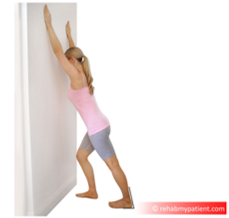
Gastrocnemius Stretch - Single Leg
Stand facing a wall, with your hands resting on the wall. Move one leg forwards and gently bend your knee, this will be the passive leg and just there for support. The leg you will be stretching will remain straight with your heel on the ground and a doorstop wedge under the ball of your foot, the thickest side under the big toe side and the thin end under the little toe side. You should feel a stretch to the leg at the back, in the calf muscle (known as the gastrocnemius).
Hold for 30 seconds Repeat 3 times 3 times daily
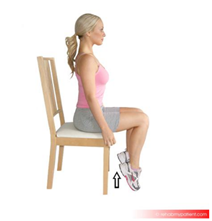
Heel rises - Sitting
Sit upright on a chair, with your feet flat on the floor. Slowly raise your legs up onto your toes. Hold, and gradually control the movement back down to the starting position. This is a useful calf pump exercise to improve circulation to your lower legs, as well as improving mobility of the ankle joints.
Perform 10 times Repeat 2 sets 3 times daily

Active Inversion - Sitting
In sitting, move your foot inwards and upwards. This is a mobility exercise for the ankle. For added movement, you could sling a dowel under your foot and, using the towel like 'reins', pull upwards with the inner hand to increase the movement
Perform for 30 seconds Repeat 2 sets 3 times daily
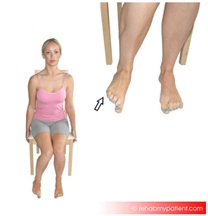
Active Eversion - Sitting
In sitting, move your foot outwards and upwards, and relax. Repeat as necessary. This will improve the mobility of your ankle. For added movement, you could sling a towel under your foot and, using the towel like 'reins', pull upwards with the inner hand to increase the movement.
Perform for 30 seconds Repeat 2 sets 3 times daily
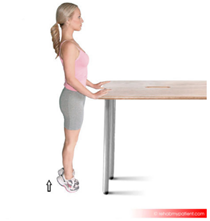
Calf Raises - Two Legs
Stand upright and hold onto a wall/table for balance if required. Slowly raise up onto your toes, and control the movement back down. This exercise will strengthen the calf muscles and ankle joints.
Perform 10 times Repeat 2 sets 3 times daily
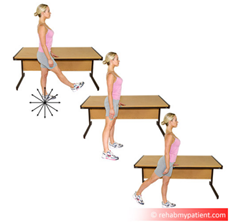
What actions can I take to improve my health?
Evidence tells us that making healthy lifestyle choices can have a big impact on influencing problems with your muscles and bones and can play a major role in your overall health. Some of the most effective areas to address are below: (click on the links)
Maintaining a healthy weight - www.nhs.uk/live-well/healthy-weight/
Increasing levels of physical activity - http://www.nhs.uk/live-well/exercise/
Avoiding poor sleep patterns - www.nhs.uk/live-well/sleep-and-tiredness/how-to-get-to-sleep/
Reducing alcohol consumption - https://www.nhs.uk/live-well/alcohol-support/calculating-alcohol-units/
Stopping smoking - http://www.nhs.uk/live-well/quit-smoking/
Maintaining a healthy mind - http://www.nhs.uk/conditions/stress-anxiety-depression/
The good news is that you are able to influence lots of these by modifying your lifestyle. Therefore it is important that you consider addressing these areas alongside your current treatment.
You may wish to discuss any of these factors with your treating clinician who will be able to work with you and guide your long term management and support you to improve your wellbeing.
There will be information about the local services that exist within the waiting areas of the physiotherapy department and your treating clinician will be able to help signpost you to appropriate services.
The websites listed below give more information on local services available:
• Blackburn and Darwen - https://refreshbwd.com/
• East Lancashire - http://www.upandactive.co.uk/
• Public Health England https://www.gov.uk/government/organisations/public-health- england
You can download a printable version of this information here.
Please note this is a PDF and does not meet accessibility needs.


